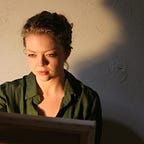Narrating Chaos- how the self searches for meaning and truth
Everyone interprets their experiences moment to moment. It happens so quickly we rarely notice what we are doing. As human beings it is natural to desire explanations for the unfolding of events. We crave a structure for our personal histories, so we impose the concept of plot on sets of facts.
Frank Kermode, one of Britain’s foremost Literary Critics, was fascinated with the human need to make sense of history. In his book The Genesis of Secrecy, he explores the problematic roles of narrative and interpretation. The countless ways in which a text can be interpreted does not make it false, but rather provides multiple ways to move beyond the weight of a world that does not make sense. There is always a difference between what happens and the account just as there is a difference between meaning and truth. As a multilayered map narrative functions as a way to position our experiences within the world. The result is a labyrinth of imbedded layers subject to interpretation.
Layers provide hiding places for ideas. A network of meaning is concealed in language. There is no discerning of absolute truth, we see what we want to see, or perhaps more acutely, we see what we are looking for. As Kermode explains, the very nature of narrative cannot exist without the interpreter:
“interpretation, which corrupts or transforms, begins so early in the development of narrative texts that the recovery of the real right original thing is an illusionary quest.”
We are unable to approach interpretation as blank canvases. We carry within ourselves internalized plot structures based on the literary expectations of our time and process every experience through that sieve. Where a chronicle of events leaves us wondering how to make sense of it all, stories provide a framework for our deeper questions of meaning and coherence in a world that rarely conforms to our expectations.
Like the narratives we generate from texts the ones we form for life necessitate exclusions. As interpreters we choose what to include in a plot. Kermode terms it “a willful narrative deafness, a preference for the interesting over the obvious and sequential.” In his book, Thinking, Fast and Slow, Nobel Prize winner Daniel Kahneman delineates the preference between interesting and sequential into the existence of two selves, the experiencing-self and the narrative-self. The narrative-self censors experiences when creating a coherent plot, a personal myth. Interestingly, instead of adding up the sum of events the mind fails to properly represent time in its stories:
“In storytelling mode, an episode is represented by a few critical moments, especially the beginning, the peak, and the end. Duration is neglected” (Kahneman).
Duration is carnal, experiential, sensation focused. Storytelling is a divination. From these momentary radiances interpreters form a picture of the whole and an imagined conclusion. This is not simple self-deception, it is a tool for survival: “The idea that the future is unpredictable is undermined every day by the ease with which the past is explained” (Kahneman). This bolsters our confidence that future will also be explainable. Still, our divinations are influenced by our concept of narrative as a type of literature which is subject to specific rules.
We crave a structure for history, a way to make sense of our personal stories with the context of a world that is made up of oppositions. Oppositions, unlike plots, offer endless interpretations. Singular order cannot be found in a plural world, but we are nevertheless hopelessly drawn to search for it amongst the fragmentation.
It is possible it is all chaos and confusion and the personal myths we form to comfort ourselves are simply narrative interpretation, a reflection of what we want to see and not what is actually there. Kermode calls this an apportionment of explanations: “the way we satisfy ourselves with explanations of the unfollowable world.” This is not a particularly beautiful image because it opens our eyes to the fact that it is very possible our lives are not following a plot line.
Fictionalization is not an escape from the incoherence of the world, it is a way of asking- what makes sense? A way to delve deeper than chronologies, than diaries, and the experiential self. By being aware that we use interpretation as a tool to make sense of chaos we are then able to view our stories from the outside and recognize the interpretive tricks we use. Our momentary radiances come from traversing the labyrinth, charting our map and looking for that which is hidden between the layers. However, we must not forget that what we find will be a reflection of ourselves. For us as interpreters the narrative map can only lead to what we are hoping to find.
